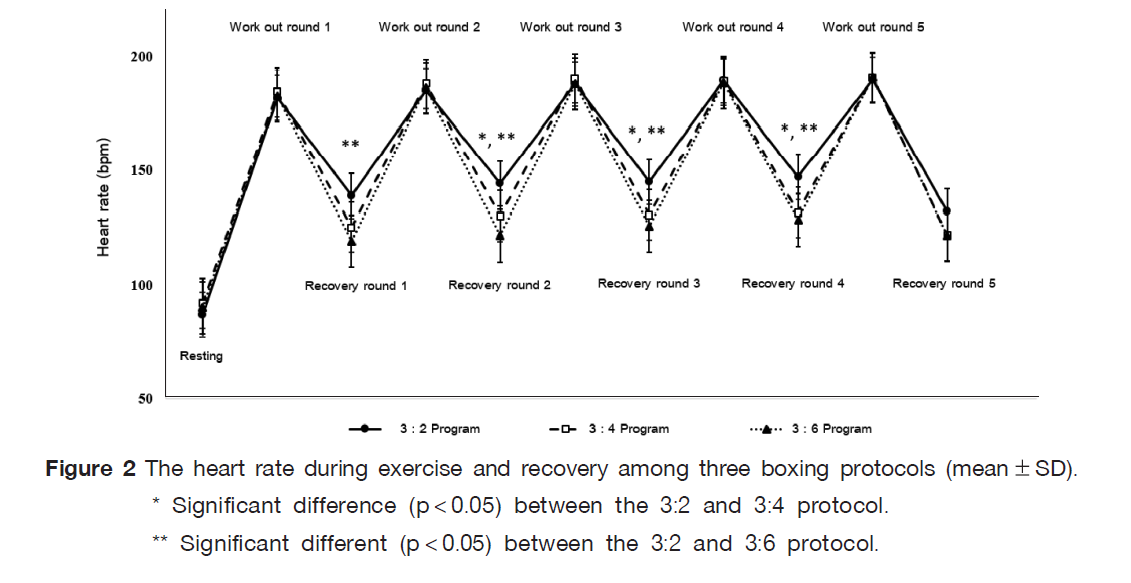INFLUENCE OF RECOVERY DURATION ON MAXIMAL INSPIRATORY PRESSURE AND HEART RATE RESPONSES DURING THAI BOXING EXERCISE IN OBESE CLASS I WOMEN
Main Article Content
Abstract
Purpose:
The purpose of this study was to assess the effects of recovery duration on maximal inspiratory pressure and heart rate (HR) responses during Thai boxing exercise in obese female subjects.
Methods: Ten obese (Class I) female subjects (aged 21.5 ± 0.5 years) participated in this study. A Thai boxing exercise protocol was completed on three separate occasions, comprising 5 3-minutes rounds, with either 2 (3:2), 4 (3:4) or 6 (3:6) min recovery. Maximum inspiratory pressure (MIP) was assessed using a hand-held mouth pressure meter before (Pre) and after (Post) the Thai boxing exercise. HR was assessed throughout exercise and during the intermittent recovery periods. Data were analyzed using ANOVA with Bonferroni post hoc analysis. A statistical significance was accepted at p < 0.05.
Results:
While HR increased (p < 0.05) during exercise in all three exercise protocols, HR was higher (p < 0.05) during recovery in the 3:2 condition compared with the 3:4 and 3:6 conditions, respectively. Moreover, MIP was lower post-exercise compared to pre-exercise in all three exercise protocols (p < 0.05), however no between-condition differences were observed (p > 0.05).
Conclusion:
This study indicated that recovery duration between rounds during Thai boxing exercise influences the recovery of HR, but not MIP, in obese class I women.
Article Details
References
American Thoracic Society and European Respiratory Society. (2002). ATS/ERS statement on respiratory muscle testing. American Journal of Respiratory and Critical Care Medicine, 166(4), 518-624.
Bischoff SC, Boirie Y, Cederholm T, Chourdakis M, Cuerda C, Delzenne NM, et al. (2017). Towards a multidisciplinary approach to understand and manage obesity and related diseases. Clinical Nutrition, 36(4),917-938.
Chen TA, Baranowski T, Moreno JP, O’Connor TM, Hughes SO, Baranowski J, et al. (2016). Obesity status trajectory groups among elementary school children. BMC Public Health, 16, 526-538.
Chidnok W, DiMenna FJ, Fulford J, Bailey SJ, Skiba PF, Vanhatalo A, et al. (2013). Muscle metabolic responses during high intensity intermittent exercise measured by (31)P-MRS: relationship to the critical power concept. American Journal of Physiology-Regulatory, Integrative and Comparative Physiology, 305(9), 1085-1092.
Coast JR, Clifford PS, Henrich TW, Stray- Gundersen J and Johnson Jr RL. (1990). Maximal inspiratory pressure following maximal exercise in trained and untrained subjects. Medicine and Science in Sports and Exercise, 22(6), 811-815.
Cohen J. (1992). A power primer. Psychological Bulletin, 122(1), 155-159.
Crisafulli A, Vitelli S, Cappai I, Milia R, Tocco F, Melis F, et al. (2009). Physiological responses and energy cost during a simulation of a Muay Thai boxing match. Applied Physiology, Nutrition, and Metabolism, 34(2), 143-150.
de Lira CA, Peixinho-Pena LF, Vancini RL, de Freitas Guina Fachina RJ, de Almeida AA, Andrade Mdos S, et al. (2013). Heart rate response during a simulated olympic boxing match is predominantly above ventilator threshold 2: a cross sectional study. Open Access Journal of Sports Medicine, 4, 175-182.
El-Ashker S, Chaabene H, Negra Y, Prieske O and Granacher U. (2018). Cardiorespiratory endurance responses following a simulated 3 3 minutes amateur boxing contest in elite level boxers. Multidisciplinary Digital Publishing Institute, 6(4), 119-127.
Johnson BD, Aaron EA, Babcock MA and Dempsey JA. (1996). Respiratory muscle fatigue during exercise: implications for performance. Medicine and Science in Sports and Exercise, 28(9), 1129-1137.
Jones AM and Vanhatalo A. (2017). The ‘Critical Power’ Concept: Applications to Sports Performance with a Focus on Intermittent High-Intensity Exercise. Sports Medicine, 47(1), 65-78.
McQueen MA. (2009). Exercise aspects of obesity treatment. Ochsner Journal, 9(3),140-143.
Mongkol S. (2012). The effect of obesity on respiratory and cardiovascular system.Journal of Associated Medical Sciences, 45(3), 10-16.
Nassib S, Hammoudi-Nassib S, Chtara M, Mkaouer B, Maaouia G, Bezrati-Benayed I, et al. (2017). Energetics demands and physiological responses to boxing match and subsequent recovery. Journal of Sports Medicine and Physical Fitness, 57(1), 8-17.
Ozkaplan A, Rhodes EC, Sheel AW and Taunton JE. (2005). A comparison of inspiratory muscle fatigue following maximal exercise in moderately trained males and females. European Journal of Applied Physiology, 95(1), 52-56.
Rabec C, De P and Ramos L. (2011). Respiratory Complications of Obesity. Arch Bronconeumol, 47(5), 252-261.
Ramar K and Caples SM. (2010). Cardiovascular Consequences of Obese and Nonobese Obstructive Sleep Apnea. Medical Clinics of North America, 94(3), 465-478.
Ramírez-Vélez R, Hernández-Quiáones PA,Tordecilla-Sanders A, Álvarez C, Ramírez-Campillo R, Izquierdo M, et al. (2019).Effectiveness of HIIT compared to moderate continuous training inimproving vascular parameters in inactive adults. Lipids in Health and Disease, 18(1), 42.
Riebe D, Ehrman JK and Liguori G MM. (2017).ACSM’s guidelines for exercise testing and prescription (10 th ed.). Philadelphia: Wolters Kluwer.
Scano G, Stendardi L and Bruni GI. (2009). The respiratory muscles in eucapnic obesity. Respiratory Medicine, 103(9),1276-1285.
Sheel AW, Boushel R and Dempsey JA. (2018). Competition for blood flow distribution between respiratory and locomotor muscles: implications for muscle fatigue.Journal of Applied Physiology, 125(3),820-831.
Tarapong C, Thanaphongwisan P, Wichianwan P, Namwong R, Wiangkham T and Chidnok W. (2019). Effect of Thai boxing exercise training on maximal ventilation in obese subject. Journal of Sport and Health Science,20(1), 88-98.
Wewege M, van den Berg R, Ward RE and Keech A. (2017). The effects of high-intensity interval training vs. moderate-intensity continuous training on body composition in overweight and obese adults: a systematic review and metaanalysis. Obesity Reviews, 18(6), 635-646.
TU, Marty J, Kerherve H, Millet GY, Verges S and Spengler CM. (2015). Aspects of respiratory muscle fatigue in a mountain ultramarathon race. Medicine and Science in Sports and Exercise, 47(3),519-527.
Zammit C, Liddicoat H and Moonsie I. (2010).Obesity and respiratory disease. International Journal of General Medicine, 3, 335-343.


